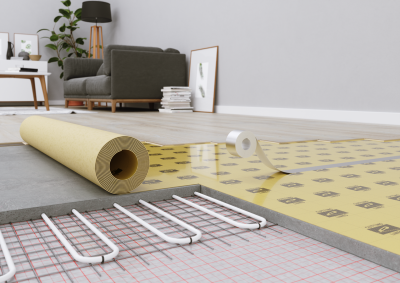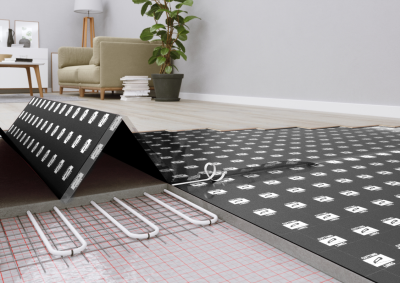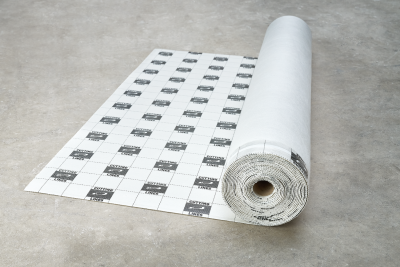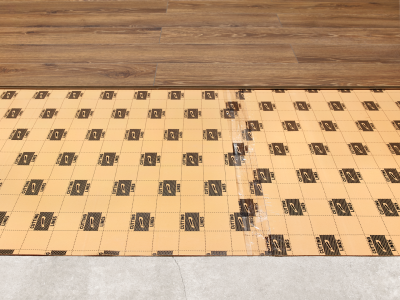Underlays
UNDERLAYS FOR VINYL PANELS
Vinyl panels require specialist underlays to take full advantage of the functions and characteristics of these great floors. Due to the small thickness of the panel and the extremely precise locks, the underlay should have a high compression resistance (CS) class - when something heavy is placed on the panels, the underlay should support them. Additionally, it should have high resistance to dynamic loads (DL), which translates into practical durability of the panels for years. In addition, vinyl panels are often chosen as a solution for underfloor heating, so the underlay should support this function, also providing excellent heat conduction.
Whichever underlay you choose from the Afirmax range, you can be sure of the highest quality and stability of technical parameters.
Form : Roll
Technology : PU+minerals+ PET
Thickness : 1 mm
Form : Smart
Technology : XPS/PET
Thickness : 1 mm
UNDERLAYS FOR LAMINATE PANELS
Underlay for laminate panels is a product that has been available and known for many years, but recently there has been a real technological breakthrough in this category. Thanks to the technology of polyurethane underlays, the Afirmax underlays available today are superior in every respect to the previously known products. First of all, they sensationally soundproof the room and eliminate the biggest disadvantage of laminate panels, i.e. deafening reverberation when walking. In addition, they protect the sensitive locks of the panels from damage and extend the life of the floor. Additionally, if we want to use panels for underfloor heating, they allow for almost lossless heat conduction.
Afirmax offers only underlays for laminate panels of the highest quality, made of the most modern materials.
Form : Roll
Technology : PUM/PET
Thickness : 2 mm
Form : Roll
Technology : PU+minerals+ PET
Thickness : 1.5 mm
UNDERLAYS ACCORDING TO EN 16354
Our laminate flooring underlays are manufactured in Poland according to the highest standards described in the European EN 16354 standard. The norm describes what requirements must be met for a product to be called an underlay, what methods must be used to test its parameters and which information must be indicated on the packaging. This norm was developed as a continuation of the standards and recommendations developed by the EPLF (European Producers of Laminate Flooring) and the MMFA (Multilayer Modular Flooring Association). Only by using an appropriate underlay complying with the requirements of EN 16354 we can be sure that we will not lose the warranty. The use of an inappropriate underlay is one of the most frequent reasons for complaints and reclamations being rejected.
REQUIREMENTS OF EN16354
The requirements of the norm are divided into two groups. In the first group we have the obligatory parameters, which every producer has to put on the label. These are technical parameters describing the quality of the underlay, they have a direct impact on the durability of the panels. Among them there are DL – dynamic load, measured in the number of cycles which the underlay must withstand without damage, and CS – static load, or otherwise: resistance to compression. The obligatory parameters are concluded by the PC parameter – the compensation of point irregularities of the substrate. It’s also mandatory to include the dimensions of the underlay under the panels, the number of square meters and additional parameters such as flatness and rectangularity of the underlay.
The most common myths associated with underlays
Underlays are the kind of products that we buy extremely rarely, so we usually don’t have our own experience of choosing and properly selecting an underlay for our needs. Even if this is not our first ever purchase of such a product, it might have been several years since the last time. We may have already forgotten how it happened… In addition, technology is advancing all the time – new and improved products appear almost every year. Therefore there are many myths, outdated beliefs or even misleading information materials available on the market. One of these myths is that the underlay we choose is the same one in every case, regardless of our needs. The parameters described in EN 16354 are an attempt to convince the market that this is not the case. Just as you can buy different kind of floors – dedicated to different rooms – we also select an underlay according to the type of room and our needs. The result of this myth is the availability of different types of polyethylene foams (foams with foil, foams with holes or in different colors) or even corrugated cardboard. According to the standard, the PE foam cannot be named as an underlay as it does not meet the requirements. If we want our floor to last several years in the same condition, we shouldn’t choose foam – choose products that meet the standards. Another very harmful myth is the one related to underfloor heating saying that an underlay for underfloor heating should have holes. NO! Air is an insulator and conducts heat very poorly, which will increase your bills. Large holes in the underlay (more than 0.5 cm in diameter) are also a big danger for the panels. The voids cause the panels to bow, damaging the locks over time and creating gaps in the panels. If you are not sure if the product you are about to buy is the right solution, look for the technical data sheet (TDS). If the sheet has only perfunctory information, a few basic parameters or does not indicate the standards – it’s a clear signal that you should be vigilant. A professional, good product comes with a sheet which indicates several parameters tested according to PN, EN or ISO standards.
TECHNICAL PARAMETERS INCREASING THE COMFORT OF USE
The second part of the requirements of the norm describes the parameters that affect the comfort level of using the floor, but also tells us about the ways to test them. Among others, we have two parameters related to acoustics. RWS – Reflected Sound Reduction (RWS) refers to the room in which the floor panels are installed; in simple terms, it’s an information about the extent in which the underlay will eliminate the clatter of the panels. The RWS value is expressed as a percentage and indicates how much quieter the underlay is than a normal PE foam. The second parameter describing acoustics is IS – sound insulation, i.e. the reduction of sound in the room below the one where the floor is installed. This value is expressed in decibels. Therefore the underlay is an additional acoustic insulation. The next parameter is the thermal resistance (R), which is the extent in which the underlay conducts and retains heat transmission. This information is used in two ways: firstly, a low R-value indicates that the underlay is suitable for underfloor heating and secondly, a high R-value will provide additional insulation if the floor panels are laid over an unheated room (e.g. a garage or cellar). In addition, the information about the protection against falling objects – RLB – gives us information about how well the underlay absorbs impacts.
Vapour barrier – combined with the underlay or as a separate foil
All flooring manufacturers in their instructions require that the flooring is insulated from residual moisture that is present in the floor. Usually a special foil is laid under the underlay. According to the standard, however, it’s possible to lay the underlay with an integrated vapour barrier. It’s important that this standard is met. Look for the value SD on the packaging; it should be at least 75 m.
Quartz mat, polyurethane-mineral underlay, PUM – top quality flooring underlays
Different names for the same top-quality underlay technology. AFIRMAX underlays are made of a combination of modern, pure polyurethane material and minerals. They are characterized by high material density, which allows them to achieve incomparably high technical parameters. Afirmax mats are very resistant to compression and dynamic loads. They have the highest classes described in the EN 16354 norm, the appropriate ones being CS3 and DL3. They will protect the new floor for many years even in very intensively used rooms. Polyurethane underlays are gaining popularity due to their soundproofing properties, as they are unbeatable when it comes to reducing the sound of clattering panels. They also provide acoustic insulation, muting the sounds heard in the rooms below. Thanks to the integrated vapour barrier, we don’t need to install an additional moisture isolation, we just need to connect the strips with a vapour barrier tape. AFIRMAX underlays are manufactured entirely in Poland, in factories belonging to a company with Polish capital, listed on the Warsaw Stock Exchange. Thanks to a modern laboratory located in our facility we constantly control the quality and repeatability of our products. We test underlays according to the standards described in the EN 16354 norm and follow the additional recommendations by EPLF and MMFA. Over 25 years of experience in production is the guarantee of an excellent quality.













